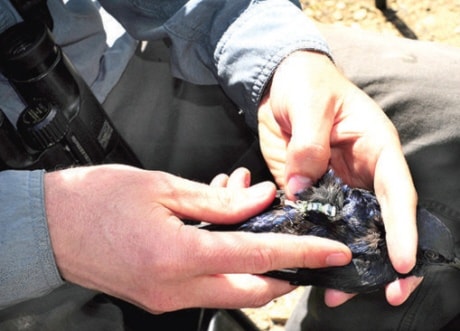Ponoka County residents can rest assured if they spot a purple martin with a small instrument harnessed to its back, they are not seeing things.
Biologist Myrna Pearman, site services manager at Ellis Bird Farm, said last season 22 purple martins were fitted with light level geolocators that contain data new to science.
These geolocators, detect and record maximum light intensities at set intervals. From these light levels, researchers are able to determine latitude and longitude that allows them to track the daily movements of each bird.
“Geolocators have been successfully deployed on several purple martin colonies in the eastern (United) States and on the West Coast. However, the exact migration patterns and overwintering locations of our northern nesting birds remains unknown,” said Pearman. “Until, we hope, this year.”
The challenge is to now find the backpacked birds when they return from their journey south.
“While we expect that most returnees will come back to Ellis Bird Farm, there is a good chance that some individuals may return to other colonies in central Alberta. We are therefore inviting all purple martin landlords to pay very close attention to their birds as soon as they arrive. There are lots of purple martins in the Rimbey area,” she noted.
She said the two small antennae may be noticed first but a scope may be needed to determine if the bird is wearing a backpack. She said all of the EBF birds have been tagged with an aluminum numbered band and some will also have either a black or a bright green colour leg band.
“Detecting a banded bird will likely be easier than seeing the geolocator antennae,” she said.
Anyone who observes a backpacked bird is asked to call Ellis Bird Farm at 403-346-2211 or send an email at (info@ellisbirdfarm.ca) Someone will immediately visit the bird colony where the bird was sighted and trap the bird carefully to record the band number and snip off the backpack.
“We hope to capture all returned birds with geolocators as soon as possible after they arrive back on territory to reduce the chance that the bird might be taken by a predator. “
Geolocators will be attached to a number of birds again this season and the public is invited to watch the operation which will be announced on the website www.ellisbirdfarm.ca
Information contained in the geolocators of returned birds will also be posted to their website.
The geolocators were attached to the birds at Ellis Bird Farm and in Camrose by Dr. Kevin Fraser from York University. Del McKinnon of the Purple Martin Conservancy (Mulhurst Bay) supervised the trapping operation and oversaw aging/sexing the birds. Dr. Geoff Holrody of the Beaverhill Bird Observatory also assisted.pr
The Alberta project is a partnership between EBF, York University, the Purple Martin Conservancy (Mulhurst Bay) and the Camrose Wildlife and Stewardship Society. Funding for the Ellis Bird Farm component of the project was provided by the Red Deer and District Community Foundation through a special designated fund.
